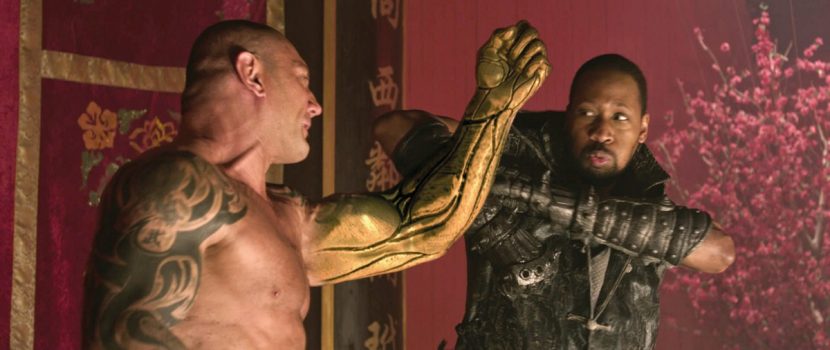Featuring some gruesome fight scenes and impressive weaponry, the R-rated The Man with the Iron Fists is certainly not for the faint-hearted. One of the more brutal characters seen in the film is Brass Body, played by former professional wrestler David Bautista, who can turn his body into metal with devastating impact. For shots of his transformation, director RZA turned to visual effects studio Gradient Effects to create the metal armour in CG.
“We were essentially given a chance to come up with a look for a character that has superpowers,” says Gradient visual effects supervisor Thomas Tannenberger. “We could write up the actual physical rules for how and when this metal shield would be deployed and what it can fend off and what it can’t.”
Below, watch a breakdown of the Brass Body visual effects by Gradient.
To do that, effects artists firstly had to match Bautista’s original movements frame by frame in the scene so that they could track a CG metal body onto him. The armour appears at first to follow the lines of Brass Body’s tattoos before becoming a layer of protective metal skin. Gradient modeled and animated the armour and then used paint and compositing techniques to have it slide on at will.
One of the biggest challenges for Gradient – working via both its LA and Istanbul offices – was that very little data was acquired on set, including tracking markers, survey data or lens information. “The character was truly developed in post production,” notes Tannenberger. “During the shoot they had thought of a different solution for Brass Body which had more to do with grading than anything else – the fact that he was given a whole different physical presence is something that was developed in the post production phase.”

Gradient launched into matchmoving of the plates, using proprietary to map the lenses and also relying on a cyberscan of the actor. They then developed a choreography for the armour scene by scene. “We’d work out what needed to happen and then go and sketch out the animation requirements and do frame by frame matchmove animation. It essentially comes on as a bit of a line drawing and then it’s followed by a second layer which is a slightly more opaque, almost like a distortion of the skin until it finally thickens up and the brass layer is brought on to complete the picture.”
To render the CG armour, Gradient looked to NVIDIA’s mental ray with its own custom shaders. “We used dual 16 Core AMD Opteron CPUs in our render arm,” says visual effects supervisor Olcun Tan. “They scaled fantastically with mental ray, especially with all the area lights we used. We use the Opterons also for heavy duty fluid simulations here at Gradient.”
“When we put light on the metal it needed to reflect the room like a mirror,” adds Tan, “so we needed these area lights to mold the look of the metallic parts. It’s like a car photo shoot where you have white lights and diffuse lights which reflect in the paint. On top of that we did a camera projection of that environment – we took planes and re-textured or projected back the black plate onto geometry in the scene which we would use as reflection objects.”
Other parts of the effects work included an encounter between Brass Body and several ‘Black Widows’, whose weapons are blade studded silk wraps. “The idea was that Brass Body uses his strength to break these belts apart and in doing so turns them against the attackers,” says Tannenberger. “He breaks out on his armour and does it with such strength that the bits and pieces of the belts basically kill the girls surrounding him. We used Maya’s nCloth for simulation and dynamics for this scene.”
Brass Body eventually meets his match against Blacksmith (RZA) who pummels Brass with his iron fists. “It creates all these sparks and other particle effects,” notes Tannenberger. “And then it starts to deform him. Brass Body literally starts to get dinged up like a crashed car until he gets torn apart from a massive hit.”
